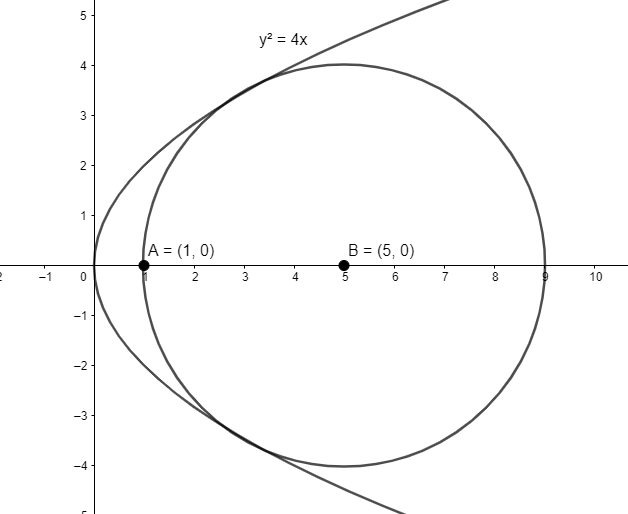
Radius of the largest circle which passes through the focus of the parabola ${{y}^{2}}=4x $ and contained in it, is
(a). 8
(b). 4
(c). 2
(d). 5
Answer
168.9k+ views
Hint: To find the radius of the largest circle which passes through the focus of the parabola and is contained in the parabola, we will find the centre of the parabola by making the general equation of circle pass through the focus of the parabola and solve it in terms of radius of the circle.
Complete step by step answer:
We have the equation of parabola as ${{y}^{2}}=4x $.
We want to find the radius of the largest circle which passes through the focus of the parabola.
We know the focus of the parabola of the form \[{{y}^{2}}=4ax\] is \[(a,0)\] .
Thus, the focus of the parabola \[{{y}^{2}}=4x\] is \[(1,0)\] .

As we want the largest circle contained in parabola \[{{y}^{2}}=4x\] and the circle passes through focus of parabola, the centre of the circle lies on \[x\] -axis.
Let’s assume that the centre of the circle is \[(h,0)\] .
Let the radius of the circle be \[r\] .
As the circle passes through \[(1,0)\] , we have \[h=1+r\] . \[(1)\]
We know the equation of circle passing through the point \[(h,k)\] is of the form \[{{(x-h)}^{2}}+{{(y-k)}^{2}}={{r}^{2}}\] .
So, the equation of our circle is \[{{(x-h)}^{2}}+{{y}^{2}}={{r}^{2}}\]
Substituting the value of \[h\] from equation \[(1)\] , we get \[{{(x-1-r)}^{2}}+{{y}^{2}}={{r}^{2}}\] .
\[\Rightarrow {{x}^{2}}+{{r}^{2}}+1-2x-2xr+2r+{{y}^{2}}={{r}^{2}}\]
\[\Rightarrow {{x}^{2}}+{{y}^{2}}-2x-2xr+1+2r=0\]
But, we know \[{{y}^{2}}=4x\] . Substituting this in the above equation, we get \[{{x}^{2}}+4x-2x-2xr+1+2r=0\] .
\[\Rightarrow {{x}^{2}}+2x-2xr+1+2r=0\] \[(2)\]
The above quadratic equation will have equal roots because the circle intersects the parabola.
We know that when the quadratic equation of the form \[a{{x}^{2}}+bx+c=0\] has equal roots, we have \[{{b}^{2}}-4ac=0\] .
Substituting \[b=2-2r,c=1+2r\] from equation \[(2)\] to the above formula, we get \[{{(2-2r)}^{2}}=4(1+2r)\] .
On further solving this equation, we get
\[\begin{align}
& \Rightarrow 4+4{{r}^{2}}-8r=4+8r \\
& \Rightarrow 4{{r}^{2}}-16r=0 \\
& \Rightarrow 4r(r-4)=0 \\
& \Rightarrow r=0,r=4 \\
\end{align}\]
But the radius of the circle can’t be 0, so, the required answer is \[r=4\] .
Hence, the correct answer is 4.
Note: We can’t solve the question without the fact that the circle passes through the focus of the parabola and touches the parabola at some point. Also, one must know that a circle with 0 radius is just a point.
Complete step by step answer:
We have the equation of parabola as ${{y}^{2}}=4x $.
We want to find the radius of the largest circle which passes through the focus of the parabola.
We know the focus of the parabola of the form \[{{y}^{2}}=4ax\] is \[(a,0)\] .
Thus, the focus of the parabola \[{{y}^{2}}=4x\] is \[(1,0)\] .

As we want the largest circle contained in parabola \[{{y}^{2}}=4x\] and the circle passes through focus of parabola, the centre of the circle lies on \[x\] -axis.
Let’s assume that the centre of the circle is \[(h,0)\] .
Let the radius of the circle be \[r\] .
As the circle passes through \[(1,0)\] , we have \[h=1+r\] . \[(1)\]
We know the equation of circle passing through the point \[(h,k)\] is of the form \[{{(x-h)}^{2}}+{{(y-k)}^{2}}={{r}^{2}}\] .
So, the equation of our circle is \[{{(x-h)}^{2}}+{{y}^{2}}={{r}^{2}}\]
Substituting the value of \[h\] from equation \[(1)\] , we get \[{{(x-1-r)}^{2}}+{{y}^{2}}={{r}^{2}}\] .
\[\Rightarrow {{x}^{2}}+{{r}^{2}}+1-2x-2xr+2r+{{y}^{2}}={{r}^{2}}\]
\[\Rightarrow {{x}^{2}}+{{y}^{2}}-2x-2xr+1+2r=0\]
But, we know \[{{y}^{2}}=4x\] . Substituting this in the above equation, we get \[{{x}^{2}}+4x-2x-2xr+1+2r=0\] .
\[\Rightarrow {{x}^{2}}+2x-2xr+1+2r=0\] \[(2)\]
The above quadratic equation will have equal roots because the circle intersects the parabola.
We know that when the quadratic equation of the form \[a{{x}^{2}}+bx+c=0\] has equal roots, we have \[{{b}^{2}}-4ac=0\] .
Substituting \[b=2-2r,c=1+2r\] from equation \[(2)\] to the above formula, we get \[{{(2-2r)}^{2}}=4(1+2r)\] .
On further solving this equation, we get
\[\begin{align}
& \Rightarrow 4+4{{r}^{2}}-8r=4+8r \\
& \Rightarrow 4{{r}^{2}}-16r=0 \\
& \Rightarrow 4r(r-4)=0 \\
& \Rightarrow r=0,r=4 \\
\end{align}\]
But the radius of the circle can’t be 0, so, the required answer is \[r=4\] .
Hence, the correct answer is 4.
Note: We can’t solve the question without the fact that the circle passes through the focus of the parabola and touches the parabola at some point. Also, one must know that a circle with 0 radius is just a point.
Recently Updated Pages
P Block Elements: Definition, Groups, Trends & Properties for JEE/NEET

Order of Reaction in Chemistry: Definition, Formula & Examples

Hydrocarbons: Types, Formula, Structure & Examples Explained

Classification of Elements and Periodicity in Properties | Trends, Notes & FAQs

Geometry of Complex Numbers – Topics, Reception, Audience and Related Readings

JEE Main 2021 July 25 Shift 1 Question Paper with Answer Key

Trending doubts
JEE Main 2025 Session 2: Application Form (Out), Exam Dates (Released), Eligibility, & More

Displacement-Time Graph and Velocity-Time Graph for JEE

Atomic Structure - Electrons, Protons, Neutrons and Atomic Models

JEE Main 2025: Derivation of Equation of Trajectory in Physics

Instantaneous Velocity - Formula based Examples for JEE

Ideal and Non-Ideal Solutions Raoult's Law - JEE

Other Pages
JEE Advanced Marks vs Ranks 2025: Understanding Category-wise Qualifying Marks and Previous Year Cut-offs

NCERT Solutions for Class 11 Maths Chapter 4 Complex Numbers and Quadratic Equations

JEE Advanced Weightage 2025 Chapter-Wise for Physics, Maths and Chemistry

Learn About Angle Of Deviation In Prism: JEE Main Physics 2025

JEE Main 2025: Conversion of Galvanometer Into Ammeter And Voltmeter in Physics

Electric Field Due to Uniformly Charged Ring for JEE Main 2025 - Formula and Derivation




